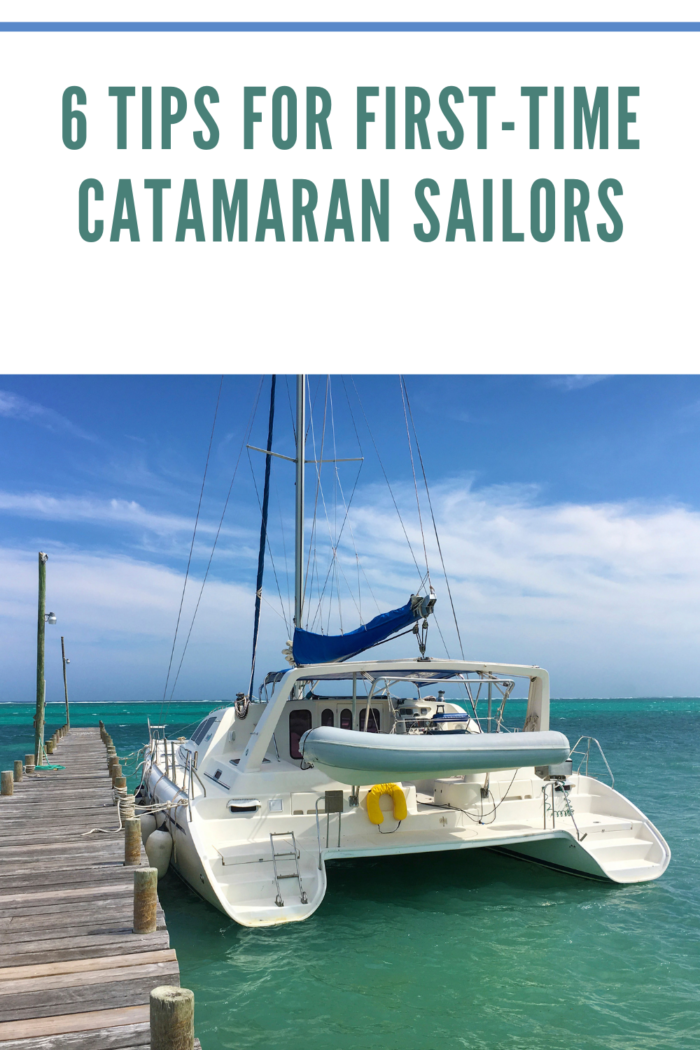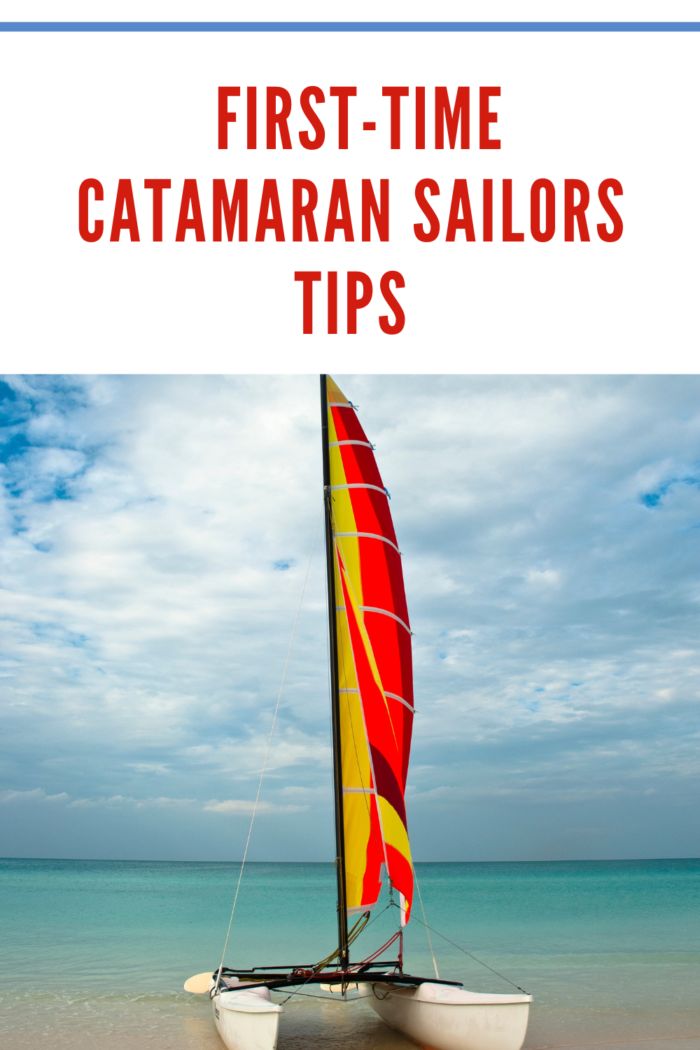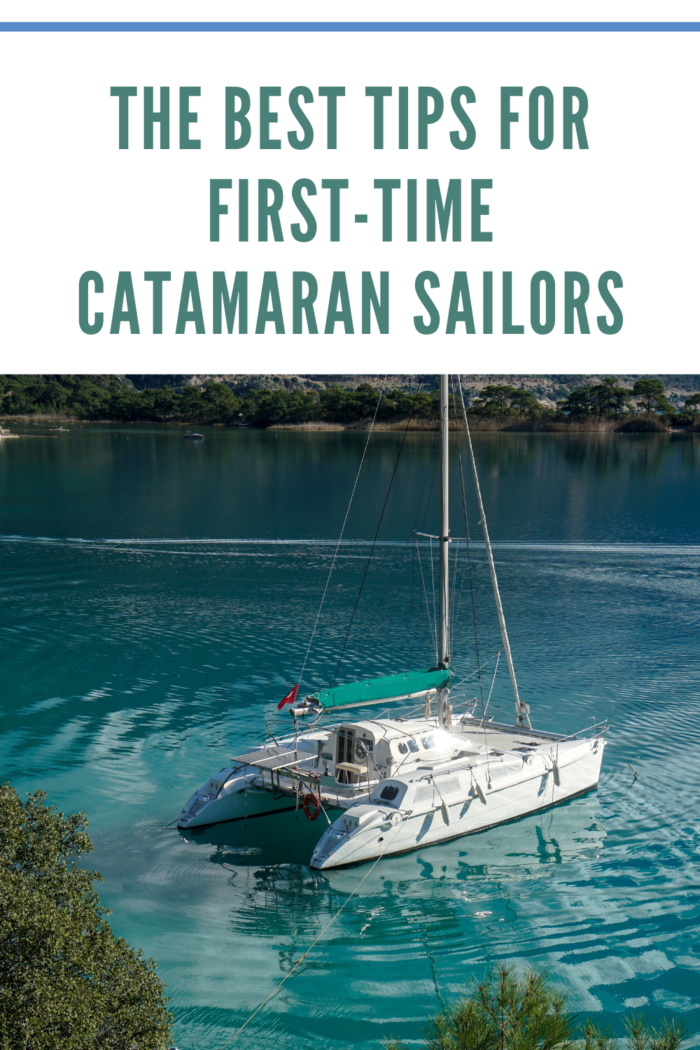🌊 Discover the Beauty of Sailing for first-time Catamaran Sailors! 🌊 We offer water wisdom with these six tips for first-time catamaran sailors.
Are you ready to embark on a thrilling catamaran adventure? Unleash your inner sailor and dive into the exhilarating world of catamaran sailing.
We understand that some things can only be truly learned by doing, and we’re here to provide you with the knowledge and skills you need to navigate the open waters safely.
Don’t miss out on this incredible opportunity to become a wise and skilled catamaran sailor. Whether you’re a complete beginner or have some experience under your belt, learn, grow, and embark on a thrilling sailing journey and unleash your inner sailor today! ⛵

6 Tips For First-Time Catamaran Sailors
Get Used To Your Boat
If you’ve been sailing on various boats, you will notice that each is different and that sailing a catamaran for the first time may seem like a completely different task. This may be the first time you are looking at power catamarans for sale for yourself. Compared to monohulls, catamarans may seem like they provide less feedback, making it harder to read if they are overpowered or heeling. The signals are there; they are just different. It will take time, patience, and some experience to get to know them.
It is crucial for a beginner catamaran sailor to familiarize themselves with their boat for the following reasons:
- Safety: Familiarity with the catamaran is paramount to ensure the safety of the crew, passengers, and the vessel itself. Understanding the layout, equipment, and systems on board enables you to navigate the boat confidently, operate essential safety features, and respond effectively in emergencies. Knowledge of safety equipment locations, such as life jackets, fire extinguishers, and emergency exits, is crucial for quick access and appropriate action if needed.
- Handling and Maneuvering: Each catamaran has its own unique handling characteristics. Becoming familiar with your specific boat allows you to understand how it responds to different wind and sea conditions, turns, accelerates, decelerates, and behaves during maneuvers such as tacking, jibing, or docking. This familiarity enhances your ability to handle the catamaran safely, maneuver it accurately, and avoid potential mishaps.
- Operating Systems and Controls: Catamarans have various onboard systems and controls that require proper understanding and operation. This includes propulsion systems, steering mechanisms, electrical systems, plumbing, navigation instruments, and other onboard equipment. Familiarizing yourself with these systems and controls allows you to operate them effectively, troubleshoot minor issues, and ensure the smooth functioning of the boat during your sailing adventures.
- Sail Trim and Performance: Understanding your catamaran’s specific sail plan and rigging setup is crucial for optimizing its performance. Familiarity with the sail trim controls, such as halyards, sheets, and travelers, enables you to adjust the sails appropriately to harness the wind efficiently. This knowledge directly impacts the catamaran’s speed, maneuverability, and overall sailing experience.
- Maintenance and Upkeep: Familiarity with your catamaran helps you identify and address any maintenance or repair needs promptly. Regular inspections of the hull, rigging, sails, and other components are essential for ensuring their integrity and longevity. By knowing your boat well, you can identify any signs of wear, damage, or potential issues, allowing for timely maintenance or professional assistance to keep your catamaran in optimal condition.
- Confidence and Enjoyment: Familiarity with your catamaran builds confidence and enhances your overall enjoyment of sailing. When you understand and feel comfortable with your boat, you can focus on the experience, scenery, and joy of being on the water. The confidence gained through familiarity allows you to relax and fully appreciate the sailing experience, knowing that you have the necessary knowledge to handle your catamaran effectively.
Taking the time to familiarize yourself with your specific catamaran is an investment in your safety, sailing proficiency, and overall enjoyment on the water. Read the owner’s manual, seek guidance from experienced sailors or instructors, and spend time exploring and practicing on your boat. The more you familiarize yourself with your catamaran, the more confident and competent you will become as a sailor.

Visibility
Sitting behind the wheel of a cruising catamaran for the first time may seem a little daunting. The sprawling interior space inevitably places limits on your visibility. Depending on the make and model of your catamaran, there will be different restrictions on various lines of sight, be sure to communicate to avoid unnecessary adventures.
Visibility is of utmost importance for a beginner catamaran sailor to understand due to the following reasons:
- Safety on the Water: Maintaining good visibility is crucial for ensuring the safety of the crew, passengers, and other vessels on the water. Awareness of your surroundings and clear visibility allows you to anticipate potential hazards, such as other boats, navigation buoys, rocks, or submerged obstacles. It enables you to take appropriate actions, such as altering course or speed, to avoid collisions and maintain a safe distance from potential dangers.
- Navigational Awareness: Clear visibility is essential for effective navigation. By having a clear line of sight, you can identify navigational markers, landmarks, and aids to navigation, which help you accurately determine your position and course. Visibility enables you to read charts, GPS devices, and other navigational instruments, ensuring you stay on the intended route and avoid getting lost or running aground.
- Collision Avoidance: A good view of your surroundings allows you to spot other vessels in the vicinity and take evasive action if necessary. This is particularly important in busy waterways, marinas, or during times of reduced visibility, such as fog or low-light conditions. Beginner catamaran sailors must understand the importance of visibility in order to maintain a proper lookout, identify potential collision risks, and navigate safely.
- Obstacle Recognition: Clear visibility helps in identifying and avoiding obstacles in the water, such as floating debris, rocks, sandbars, or shallow areas. Being able to see these hazards in advance allows you to adjust your course or depth to avoid any potential damage to the catamaran’s hull or grounding situations.
- Communication with Crew: Good visibility enables effective communication with the crew members on board. It allows for clear visual signals, hand gestures, or verbal communication between the helmsperson and crew members, enhancing teamwork and coordination during maneuvers, docking, or mooring.
- Emergency Situations: In case of emergencies, such as a man overboard situation or equipment failure, visibility becomes even more critical. It allows you to quickly locate and keep sight of the person or object in distress, enabling prompt and effective rescue efforts. Good visibility also helps you communicate your situation to nearby vessels or shore-based authorities for assistance.
Understanding the significance of visibility and maintaining a clear line of sight is essential for the overall safety, navigation, and enjoyment of catamaran sailing. Beginner sailors should prioritize visibility and ensure they have proper lookout techniques in place to maintain a vigilant and aware approach to their surroundings.

Windage
You’ve probably realized that dealing with a catamaran with a generous amount of accommodation is also going to have a generous amount of windage. The windage issue and poor visibility may seem daunting at first, having two engines set so far apart provides a balance against the negative aspects of windage and will get you out of a lot of trouble.
Understanding windage is important for a beginner catamaran sailor for several key reasons:
- Sail Trim and Performance: Windage refers to the effect of wind on the exposed surfaces of the boat, including the mast, rigging, and any other protruding structures. It is crucial for beginners to grasp the concept of windage as it directly affects the performance and sail trim of the catamaran. Windage can create additional drag, reducing the boat’s speed and efficiency. By being aware of windage, sailors can make adjustments to minimize its impact, optimize sail trim, and harness the power of the wind more effectively.
- Maneuvering and Handling: Windage significantly affects the handling and maneuverability of a catamaran. Understanding windage allows beginner sailors to anticipate how the wind will impact their boat’s response and control. Windage can cause the boat to drift or be pushed off course, especially in challenging conditions or while performing maneuvers such as tacking or jibing. Being aware of windage helps sailors anticipate and compensate for its effects, allowing for better control and maneuvering of the catamaran.
- Docking and Mooring: Windage plays a critical role in docking and mooring maneuvers. When approaching a dock or mooring buoy, the wind can push the catamaran off course or cause it to drift undesirably. Beginner sailors need to understand windage to adjust their approach and compensate for wind effects during these maneuvers. Proper awareness of windage helps prevent collisions, damage to the vessel, and potential safety hazards during docking or mooring situations.
- Safety Considerations: Windage awareness is essential for maintaining the safety of the crew and the catamaran. In strong winds, windage can make the boat more vulnerable to tipping or capsizing. Understanding windage allows sailors to make informed decisions regarding sail reefing, adjusting sail areas, or altering the course to mitigate risks associated with excessive windage. By managing windage effectively, beginners can sail safely and confidently in various wind conditions.
- Environmental Factors: Windage can also affect the boat’s interaction with the surrounding environment. For instance, when navigating narrow channels, bridges, or marinas with other vessels nearby, windage can impact the clearance, clearance time, and overall maneuverability of the catamaran. By considering windage, beginner sailors can plan their routes, approach, and timing appropriately, avoiding potential collisions or navigation difficulties.
Understanding and accounting for windage is essential for a beginner catamaran sailor’s overall safety, performance, and enjoyment on the water. By developing an awareness of windage and learning how to manage its effects, sailors can optimize sail trim, improve maneuvering, and ensure a smooth and controlled sailing experience in different wind conditions.

Maneuvering With Twin Engines
Having two engines means you can forget about the rudders when maneuvering at low speeds, which can be quite beneficial if you’re moored tightly between two other cats and need to get quite a way sidewards to get clear.
The tip “Maneuvering With Twin Engines” is important for a beginner catamaran sailor to know for several reasons:
- Enhanced Maneuverability: Catamarans equipped with twin engines offer exceptional maneuverability. Each engine can be operated independently, allowing for precise control of each hull. This enables you to execute maneuvers such as docking, turning, and navigating in tight spaces with greater ease and accuracy. Understanding how to effectively utilize twin engines empowers beginners to handle their catamaran confidently and navigate challenging situations.
- Increased Safety: Maneuvering with twin engines provides an added layer of safety. In critical situations, such as strong currents, high winds, or congested areas, having the ability to control each engine separately offers more control and responsiveness. You can counteract external forces, maintain stability, and ensure the safety of your crew and the vessel.
- Versatility in Handling Conditions: Different weather conditions and waterways may require specific maneuvers for optimal safety and performance. With twin engines, you can adjust power distribution between the hulls, allowing you to adapt to varying situations effectively. This versatility is particularly useful when encountering crosswinds, navigating narrow channels, or handling rough seas. By mastering maneuvering with twin engines, beginner sailors can confidently tackle diverse conditions.
- Efficient Station Keeping: Station keeping refers to maintaining a stationary position in the water, which can be challenging in adverse conditions. Twin engines facilitate precise control over the catamaran’s position, making it easier to stay in place while waiting for a bridge opening, anchoring, or conducting tasks that require stationary positioning. This skill is valuable for both safety and convenience during your sailing adventures.
- Redundancy and Emergency Preparedness: Having twin engines provides redundancy, which is crucial for emergency situations. In the event of an engine failure or technical issue with one engine, you can rely on the other engine to power the vessel and safely navigate to shore or seek assistance. Being familiar with maneuvering using twin engines ensures you are prepared to handle unexpected circumstances and maintain control of your catamaran.
Remember to familiarize yourself with the specific controls, operating procedures, and manufacturer’s recommendations for your catamaran’s twin engines. Take the time to practice maneuvering with twin engines in a controlled environment under the guidance of experienced sailors or instructors. With experience and proficiency, you’ll gain confidence in utilizing twin engines to maximize the maneuverability and safety of your catamaran.
Cruise On One Engine
Having the two engines that a cat provides is great for maneuvering at low speeds and safety in general, but when cruising, one engine will get you there. Using both engines will only add another few knots of speed. Catamarans are quite efficient boats running on just one engine (Yachting World), saving you fuel. Running both engines at cruising speed means twice the fuel consumption for an extra knot of boat speed. You needn’t be concerned if you’re worried about the boat becoming off balance using only one engine. Sailboats are subjected to many different forces affecting balance that need to be taken into consideration, and running on one engine means the propulsion force is not aligned with the center of lateral resistance. Still, a relatively small rudder angle is enough to counter-prop the helm.
The tip “cruise on one engine” is important for beginner catamaran sailors to know for several reasons:
- Maneuverability: Catamarans are typically equipped with two engines, one on each hull. By cruising on one engine, beginners can practice and improve their maneuvering skills. Operating with a single engine allows you to understand how the catamaran responds to different throttle inputs, steering adjustments, and wind conditions. It helps develop a better feel for the boat’s handling characteristics and increases overall confidence in maneuvering the vessel.
- Fuel Efficiency: Cruising on one engine can significantly improve fuel efficiency. By operating a single engine, you reduce fuel consumption compared to running both engines simultaneously. This tip becomes especially relevant during long-distance journeys or when fuel conservation is important. Learning to cruise efficiently on one engine not only saves money but also promotes environmentally conscious sailing practices.
- Engine Familiarity: By cruising on one engine, beginners can gain a deeper understanding of how the engines operate individually. This hands-on experience allows sailors to become more familiar with the engine controls, throttle response, and potential issues that may arise. It provides an opportunity to troubleshoot engine-related problems effectively and boosts overall engine knowledge.
- Emergency Situations: Understanding how to operate and control the catamaran effectively on a single engine is crucial in emergency situations. If one engine fails or encounters a technical issue, being comfortable with cruising on one engine ensures that you can navigate safely back to port or continue your journey without compromising your safety or that of your crew.
- Skill Building: Sailing a catamaran requires a diverse set of skills. Learning to cruise on one engine adds another dimension to your sailing abilities. It expands your knowledge of boat handling, propulsion systems, and decision-making in various scenarios. By practicing this technique, you become a more versatile sailor capable of adapting to different situations and challenges on the water.
Remember, it’s essential to consult the specific guidelines and recommendations provided by the catamaran manufacturer or sailing school regarding cruising on one engine. They may have specific instructions tailored to the design and capabilities of your catamaran. With practice and experience, you’ll gain confidence in your abilities to handle a catamaran on a single engine, enhancing your overall sailing proficiency.
Be Sure To Clean Your Hulls
Even though catamarans have two hulls, the total wetted area of a catamaran is generally less than that of a similar-sized monohull boat. This means that it takes less time for marine growth to spread itself over a larger fraction of your hulls, so you must be sure to clean them regularly and thoroughly.
Cleaning the hulls of a catamaran is of utmost importance for several reasons:
- Performance Optimization: The cleanliness of the hull directly affects the performance of the catamaran. Over time, marine growth such as algae, barnacles, and other organisms can accumulate on the hull, creating drag and reducing speed. Regular hull cleaning ensures a smooth surface, allowing the catamaran to glide effortlessly through the water and maintain optimal speed and fuel efficiency.
- Maneuverability and Control: A clean hull enhances the catamaran’s maneuverability and control. The presence of marine growth can disrupt the water flow around the hull, affecting stability and responsiveness. By keeping the hull clean, you ensure better handling, improved steering, and overall control of the catamaran, especially during maneuvers such as tacking, jibing, or docking.
- Extended Lifespan: Cleaning the hull regularly helps protect the catamaran’s structure and extends its lifespan. Marine organisms can attach themselves to the hull and penetrate the gel coat, leading to corrosion, pitting, and osmosis. By removing these organisms and maintaining a clean surface, you prevent potential damage, reducing the need for costly repairs and prolonging the life of your catamaran.
- Fuel Efficiency: A dirty hull increases fuel consumption. When marine growth accumulates on the hull, the catamaran requires more power to maintain speed, resulting in higher fuel consumption. By keeping the hull clean, you improve fuel efficiency, reducing operational costs and minimizing your environmental impact.
- Safety: Cleaning the hull is also a safety measure. Marine growth can make the hull slippery, posing a risk for crew members moving around the boat. Additionally, excessive accumulation of marine growth can affect the accuracy of depth sounders and other instruments, potentially compromising navigation and safety.
To ensure optimal performance, safety, and longevity of your catamaran, regular hull cleaning is essential. Whether through manual scrubbing, pressure washing, or using environmentally friendly hull cleaning products, keeping the hull clean will help you sail smoothly, enjoy better control, and protect your valuable investment.
Final Thoughts
Unforgettable Memories: Catamaran sailing is not just about learning; it’s about creating lifelong memories. Join a vibrant community of sailing enthusiasts, forge new friendships, and discover the camaraderie that comes from sharing unforgettable adventures on the open sea. From picturesque sunsets to exhilarating races, every moment will be a treasure.
Your best bet is to surround yourself with more experienced sailors and to learn from them as you go rather than have to learn from costly or dangerous mistakes that you may make, landing yourself in trouble. Having experienced sailors with you will also take some of the stress away and make your trip a more enjoyable experience.
